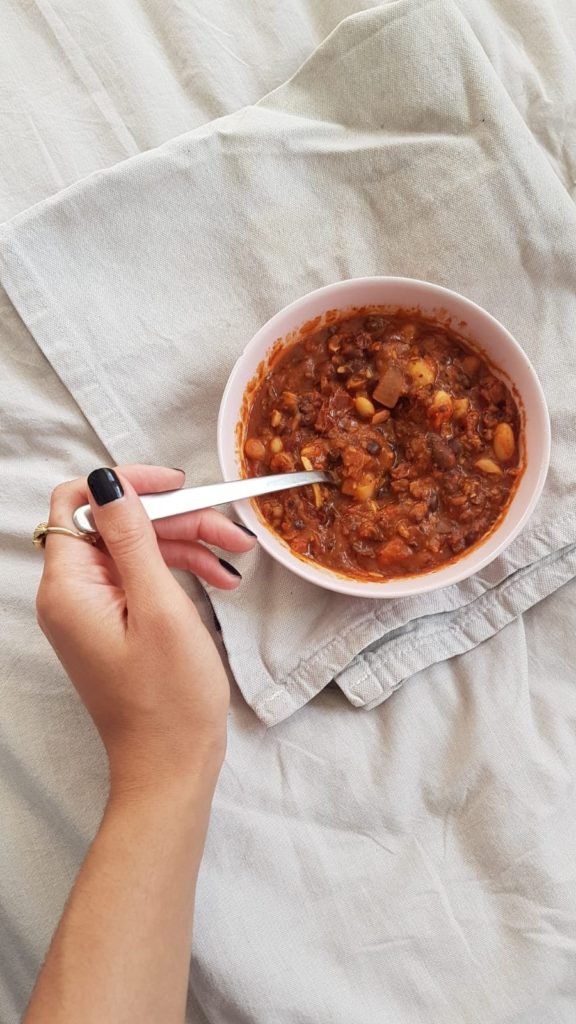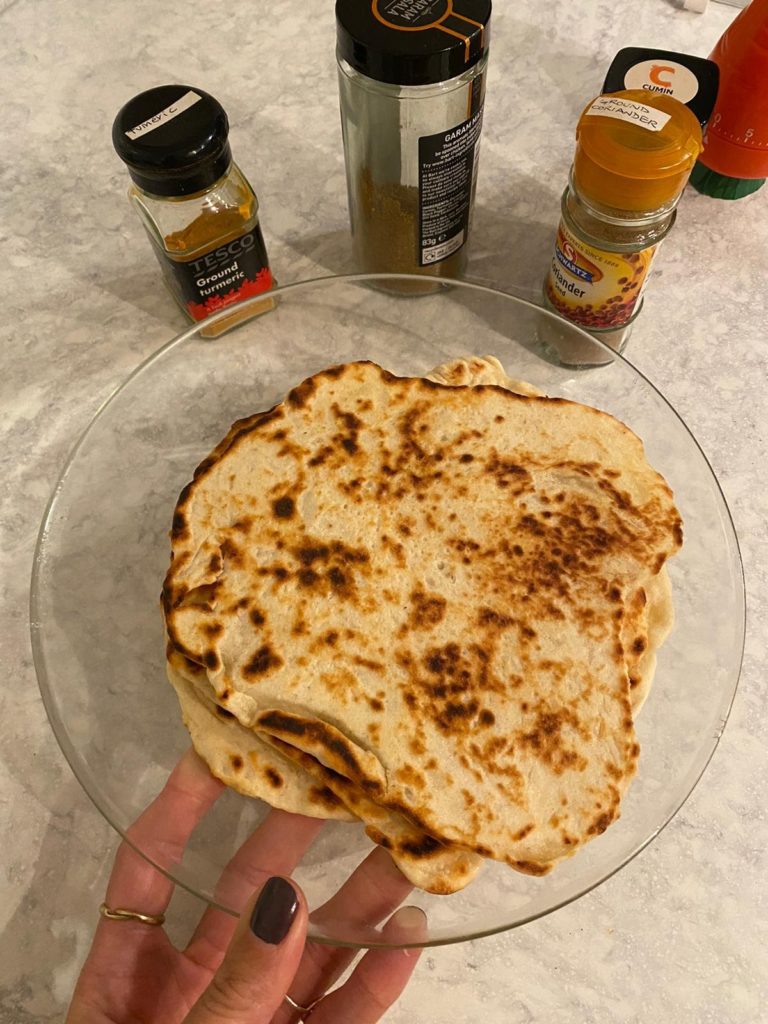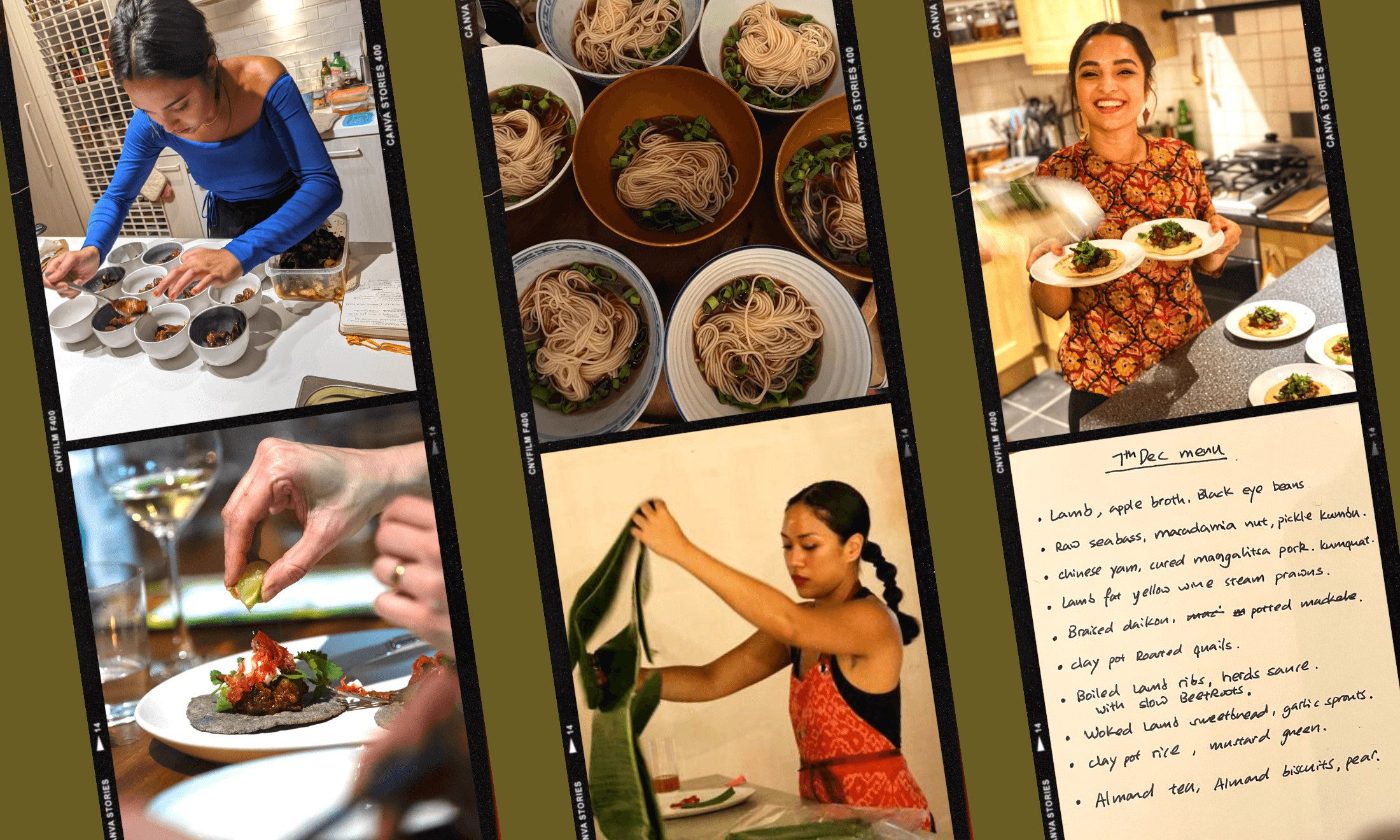
Storecupboard meal tips to nourish and inspire during lockdown
From hand-pulled noodles to freshly baked flatbread, Leah offers gal-dem's favourite storecupboard recipe ideas to break through the monotony of mealtimes in lockdown.
Leah Cowan
11 Apr 2020
We are staring down the barrel of an indefinite period of “lockdown”. Some people are being forced to consider, for the first time in their lives, what it truly means to stay indoors and put together meals in a more planned-out or restricted way. Of course for many, these challenges were a reality before lockdown. It’s notable that finding sustainable solutions to the difficulties of a world designed around a specific version of mobility are only now entering the mainstream. Eating will be a key concern for lots of people during this time, for different reasons, and the reality is that Britain’s welfare system was already failing us even before the global pandemic pushed more people into hardship.
One in 50 households used a food bank last year, and now applications to Universal Credit (the UK’s welfare support system) have increased ninefold in the past two weeks, and food banks are experiencing increased pressure. Others will be relying on friends, neighbours and mutual aid volunteers to do their shopping; lots of us will be shopping less frequently and trying to make use of good value long-life groceries to keep us nourished and grounded in the face of upheaval and increased precarity. But if you’re not used to cooking with long-life goods, or expanding your mealtime options, where do you begin?
The first step is to recognise that it’s ok to feel freaked out and worried. As Ruby Tandoh explains in Eat Up!, eating is the process by which the outside world merges with our inner being. That’s a big deal. When the external goings on are chaotic and strange, we can also anticipate that how we eat, and what we feel like eating (if we have the choice) might undergo some changes. I definitely find that my appetite is guided by my emotions. At times of sadness I seek out nourishing dishes like kimchi-jigae to lift my mood with the tangy heat of fermented cabbage; when feeling tired and de-energised I crave the bright sugar hit of sour sweets, and if I’m feeling confused and floaty I regain sturdiness by cooking up a chilli, allowing the earthy beans to tether me back to back down.
For anyone struggling to keep their taste buds stimulated and spirits bolstered in these troubled times, and beyond, we’ve compiled some low-cost store-cupboard meal tips that won’t leave you musing “flavour? I do not know her”.
Bean there, done that
Dried beans – more cost-effective than tinned beans – are great for adding protein and bulking out a meal. Your local corner shop might have a wider range than the supermarket; try creamy borlotti beans, earthy black-eyed peas, or savoury chickpeas. Our Life Editor Niellah recommends this warming curried channa and aloo recipe and our Music Editor Tara has a quick hack for spicing up a tin of baked beans: add fried onions (dried would work), garlic and ginger (pastes are fine); cumin seeds, curry powder, mustard seeds or curry leaves if you have them, and some chillies (if you’re nasty). Chickpeas can also be roasted with some oil and seasoning to make a salty snack – patting the chickpeas dry with some kitchen towel before you bake them helps to get that ultimate crispy finish.
After centuries of leaning in, chickpeas are of course dominating the dip market as the essential hummus ingredient. However, most beans mash well into a tasty dip which keeps well in an air-tight container in the fridge for up to a week, or longer if you freeze hummus in small batches. Bean dip also provides a great base for pulling together simple but flavourful meals. You can thin hummus with olive oil and vinegar and toss it with pasta and black pepper; stir it into tinned soup to add umami creaminess, and combine it with coarsely mashed chickpeas and your preferred seasoning to make bean patties (roll in flour and fry on both sides in a little oil, for about 8 minutes).
This vegan chilli recipe by American chef J. Kenji López-Alt makes the best chilli I’ve ever tasted – honestly, please bury me with a bowl of it when my time comes.

J. Kenji López-Alt’s Vegan chilli
If you don’t have all the different chilli varieties just use whatever you have (as much as you can handle, to really blow away the cobwebs). The soy sauce, marmite, and vodka gives it a great kick, but if you sub any of these items out just add more salt to compensate. If you’re done with beans (and that time will come), dried soya mince is great for adding to stews and chilli and doesn’t take up freezer space; simply rehydrate it with boiling water or stock.
Below is my recipe for no fuss no frills bean stew. It takes about 5 minutes to throw together, and then you can stand over the bubbling pot for as long as it takes to hex the white supremacist heteropatriarchy.
White bean and tomato stew
Makes two big portions, or you can stretch it further if you serve with rice or bread
Method:
1. Drain 2x 400g cans of beans (white beans such as cannellini beans work well, but any bean will do really). Add to a saucepan.
2. Add 3x cloves of minced garlic (or garlic paste), a generous amount of chilli flakes (or fresh chilli), and chopped sundried tomatoes if you have them (not vital).
3. Add 1x 400g can of chopped tomatoes, and heat over a medium heat.
4. To bulk out the stew to your required size/consistency, add a few splashes of stock and a squeeze of tomato puree, or a second tin of chopped tomatoes if you have it. Simmer for around 10 minutes.
5. Stir in a tablespoon of tahini – the hero ingredient in this recipe. At this stage you could chuck in some frozen spinach for a folic acid hit! Let the stew simmer a little longer.
6. Add more tahini if you want it to be creamier. Season with salt and pepper to taste.
Lentil we meet again
As someone dealing with the heartbreak of being separated from my partner during lockdown, I’ve been cooking a lot of daals. There’s something therapeutic about breathing in the fragrant spices and letting my mind drift with the repetitive motion of stirring. My go-to daal is Meera Sodha’s tarka dal recipe which uses very quick-cooking mung dal (the split yellow insides of green mung beans), and I’m looking forward to spending four hours cooking Dishoom’s house black dal when I inevitably get sick of Houseparty. Tara recommends this masoor dal recipe which is pretty simple, and this recipe for khichdi – a comforting dish made from rice and lentils – and if you don’t have ghee, oil is perfectly fine.
Against the grain/wheat, pray, love
If you’re able to get it, couscous is a good alternative to rice and easy to prepare. Cornmeal is a versatile Caribbean favourite which is typically used to make porridge or can be served as a savoury dish topped with roasted vegetables or tinned fish. This is the basis of the Bajan dish cou cou (normally served with flying fish rather than Tesco frozen cod fillets, but desperate times). Different breads can be easily made from flour and water – my sister made this easy two-ingredient flatbread (perfect for using up yoghurt on the turn), or you can bake your own dumplings or roti.

Two-ingredient flatbread
Some of the best pasta dishes are the simplest. The general rule is that spaghetti pairs well with thin oil or cream-based sauces that cling to the long strands, and chunkier sauces sit well in the grooves and hollows of bigger pasta shapes like fusilli or penne (which is why hearty bolognese is traditionally made with the long flat tagliatelle or wide pappardelle pasta, and not flimsy spaghetti – who knew?). Of course, in a time of coronavirus, rules go out the window, and we find ourselves eating spoonfuls of pesto straight from the jar and skipping the pasta altogether. And that’s ok.
Spaghetti aglio e olio is a dish from Naples composed of just three ingredients: spaghetti, oil, garlic and sometimes chilli flakes. In this recipe, the late Italian chef Antonio Carluccio adds anchovies (another store cupboard favourite) and colatura (fish sauce) – more salt, basically. Pasta mollicata is a dish from the Basilicata region of Southern Italy, and the key component is stale bread, which becomes crunchy toasted breadcrumbs, giving this simple dish a satisfying salty bite. My top tip for making stale bread into breadcrumbs is to toast it and then either use a grater to breadcrumb it, or put the toast slices in a sandwich bag and use your pent-up lockdown energy to bash it up.
Oodles of noodles
Dried noodles are cheap, easy to cook and a comforting classic perfect for arming yourself against chilly April showers, or cheering up your girlfriend (over Zoom, if you’re not in a lockdown love nest, bah). You can customise your ramen by adding things like a boiled egg, a tin of coconut milk, a dollop of peanut butter, vegetables (frozen and tinned work well and can be chucked straight in with the noodles as they simmer), tinned meat (spam is a great addition), or by whisking an egg into the broth. Eggs are not as perishable as expiry dates would have us think: they can last for 1-4 weeks if refrigerated properly and can be frozen for up to a year (although not in their shells – apparently you can crack open the eggs and freeze the contents in an ice-cube tray).
If you can’t get your hands on dried noodles, our Head of Editorial Charlie suggests the below recipe for making your own using just flour and water.
Hand-pulled noodles
This specific type are called biang biang noodles (also known as belt noodles), from Shaanxi. Hand-pulled noodles are Chinese fast food and are a massive deal in East Asia. Depending on how you want to make them (and how dextrous you are), with this dough you could also make knife-cut noodles.
Method:
1. Weigh 250g of plain flour and half a teaspoon of salt. Add 130g water, combine into a rough ball and knead it for five minutes! The dough should be dry, but if it’s falling apart, add more water 1 tablespoon at a time.
2. Tip out and knead on a dry surface. Leave it to rest for 30 minutes with the bowl over the top/wrap in clingfilm.
3. Knead it again for five minutes!
4. Relax it for 10 minutes. Start preparing whatever you plan to add to your noodles – such as your vegetables.
5. Roll the dough out into a rectangle and brush with oil using your fingers on both sides. Let it rest again for 30 mins.
6. Once 30mins is up, boil a pan of water.
7. Cut the dough into strips – between 1cm-3cm wide depending on how thick/wide you want your noodles.
8. Start pulling (more details on the pulling method here)!
9. Drop noodles into the boiling water one at a time or all at once.
10. Cook for 5-8 minutes, then tip into a colander.
11.Fry your vegetables.
12. Add noodles, and then add liquids (soy sauce, a splash of water etc).
Enjoy!
These tips are just a starting point – there are loads of great chefs and bakers sharing low-cost meal recipes such as Jack Munroe and Ruby Tandoh.
When everything is changing around me, I find it useful to take stock of what I can control. Even small things, like twirling a bowl of spaghetti in oil and chilli and opening a window to feel the spring breeze can feel like a mini victory, shifting my mood and energy into the next step of the day. Great food doesn’t have to be complicated, it doesn’t even have to be good. The sour smokey quality of burnt toast can be as invigorating as a premium roast black coffee: value judgements will get us nowhere, but great snacks can save the day.
Just like every great love story, food can be both overwhelming and deliciously simple. However, in these tricky times, there is comfort to be found in watching over a bubbling pan of lentils; reminding us to take a breath, and resting for a moment in the tendrils of steam which weave, like a protective charm, around us.
If you’d like support with getting food, you can access your local food bank here
If you’re struggling with eating, support is available here







